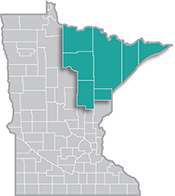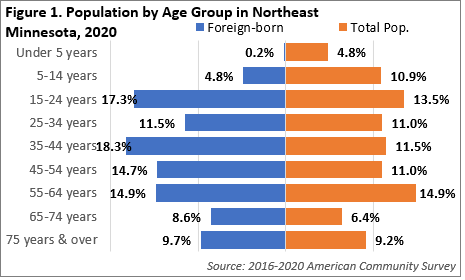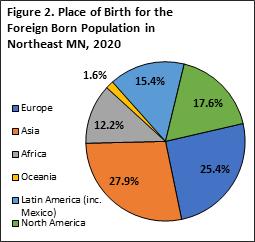 Home to the state's second-largest metro, the Northeast Region has a strong industrial sector, tied largely to the area's abundant natural resources.
Home to the state's second-largest metro, the Northeast Region has a strong industrial sector, tied largely to the area's abundant natural resources.
Most of the manufacturing base centers on mining and forest products industries. More than half of the sector's employment is in paper and machinery manufacturing.
Want the freshest data delivered by email? Subscribe to our regional newsletters.
5/17/2022 9:00:00 AM
Carson Gorecki
Amid one of the tightest labor markets in recent memory, policymakers and businesses are exploring every possible way to expand their local and regional workforces. Labor market tightness is not unique to Northeast Minnesota and domestic attraction of workers faces considerable competition. As a result, one source of workers that is increasingly being sought out by employers and policymakers are international immigrants.
Among the benefits of international immigration is increased labor force participation. Nationwide, the labor force participation rate in 2020 for the foreign-born population sat at 66.5%, compared to 62.8% for the population born in the U.S. In Minnesota there was a similar gap, with a foreign-born labor force participation rate of 72.7% and a native-born labor force participation rate of 68.9%.
In Northeast Minnesota, in-migration – both domestic and international – has played an important role in slowing what has been a trend of population decline (as the population goes, more often than not so goes the labor force). In the region, there were more deaths than births, leading to population decline. Without immigration, the regional population would have fallen another 2,500 people between 2010 and 2021 (see Table 1).
| Table 1. Cumulative Estimates of the Components of Population Change, 2010-2021 | |||||||
|---|---|---|---|---|---|---|---|
| Total Population Change | Natural Increase | Vital Events | Net Migration | ||||
| Births | Deaths | Total | International | Domestic | |||
| Northeast | -3,305 | -5,518 | 36,150 | 41,668 | +2,493 | +1,904 | +589 |
| Minnesota | +354,305 | +279,944 | 782,652 | 502,708 | +76,939 | +130,212 | -53,273 |
International migration has slowed during the pandemic throughout Minnesota. From 2020 to 2021, the state welcomed net international in-migration of only 4,200 people, well less than half the previous decade's annual average. Despite the many barriers to international migration, more people continued to move into Northeast Minnesota from other countries than those who left Northeast Minnesota for other countries, adding to the region's population and labor force. In addition, net domestic migration actually grew in Northeast Minnesota during the pandemic. At the same time, the state saw a loss of nearly 16,000 people from 2020-2021.
 The foreign-born population is more likely to include people in their prime working ages (25-54), meaning a decline of international immigrants would also be more likely to negatively impact the growth of the regional labor force (see Figure 1). The inverse is of course also true. If we were to increase international immigration, the labor force would likely benefit.
The foreign-born population is more likely to include people in their prime working ages (25-54), meaning a decline of international immigrants would also be more likely to negatively impact the growth of the regional labor force (see Figure 1). The inverse is of course also true. If we were to increase international immigration, the labor force would likely benefit.
Who makes up Northeast Minnesota's current foreign-born population of 6,727? Almost 60% are naturalized U.S. citizens and almost a quarter immigrated in the last 10 years. There is also a significant, more established group of foreign-born residents that arrived before 1990, representing about 38% of the foreign-born population. Compared to the total population, the foreign-born population is both more likely to have a high school education or below as well as slightly more likely to hold a bachelor's degree. The foreign-born population is also 1.7 times as likely to hold an advanced degree, evidence that foreign-born residents have larger shares of the lowest and highest educated. Those born in the U.S. were much more likely to have attended some college or earned an associate's degree. Lastly, of the foreign-born population in the region, 56% speak a language at home other than English. Only 14% of those that do not speak English at home do not speak English very well or not at all.
 Just over half of the foreign-born people currently living in Northeast Minnesota were born in either Asia (27.9%) or Europe (25.4%) (see Figure 2). North America (17.6%) and Central and South America (15.4%) account for about another third. While the total population declined -0.2% from 2010-2020, the foreign-born population grew by 801 people or 13.5%. Since 2010, the fastest growing foreign-born populations have been East Africans (+470, +500%), West Africans (+127, +282%), and West Asians (+168, +237%). The foreign-born groups seeing the largest relative declines over the same period were those born in Middle Africa (-71, -86%), Southern Africa (-25, -57%), and Southern Europe (-43, -39%).
Just over half of the foreign-born people currently living in Northeast Minnesota were born in either Asia (27.9%) or Europe (25.4%) (see Figure 2). North America (17.6%) and Central and South America (15.4%) account for about another third. While the total population declined -0.2% from 2010-2020, the foreign-born population grew by 801 people or 13.5%. Since 2010, the fastest growing foreign-born populations have been East Africans (+470, +500%), West Africans (+127, +282%), and West Asians (+168, +237%). The foreign-born groups seeing the largest relative declines over the same period were those born in Middle Africa (-71, -86%), Southern Africa (-25, -57%), and Southern Europe (-43, -39%).
Refugees are a specific subset of international immigrants. Refugees, many of which were forced to flee their home countries often require more assistance from the communities in which they arrive. DEED is working to provide resources to help employers connect with these New Americans. A recent CareerForce event focused on how Minnesota employers can welcome New American employees. In addition, a Workforce Wednesday event from November 2021 hosted a panel of experts to discuss how collaboration between community-based organizations and employers can help to access immigrant and refugee talent pools in Minnesota.
Local efforts to make Northeast Minnesota more welcoming to immigrants and people of color are under way. Northspan, University of Minnesota Extension, and Voices for Ethnic and Multicultural Awareness (VEMA) are only a few of the groups thinking about and organizing around these issues locally.
Despite strong growth, Northeast Minnesota's foreign-born population remains relatively small, about 3% of the total population. Any new community member of working age represents a new opportunity for local employers to fill one of their many open positions and at the same time add some new and diverse perspectives to their workforce. Considering recent trends of low population growth and labor force decline, encouraging and welcoming an individual or family from another country is a relatively quick way to expand the regional labor force and a good complement to development of the existing population. While both approaches should be pursued, supporting international immigration may be one of the quickest ways to alleviate the workforce shortage many communities and businesses are feeling right now.
Contact Northeast Minnesota Labor Market Analyst Carson Gorecki at 218-302-8413.